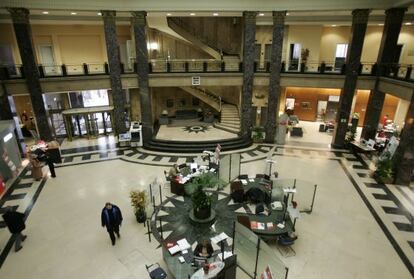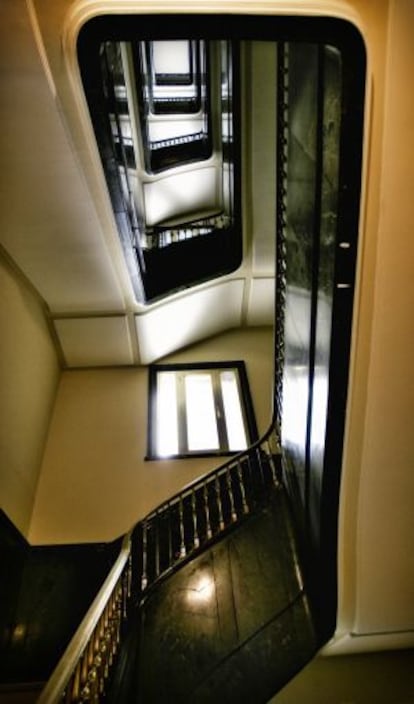Is Madrid's commitment to its heritage just a façade?
The redevelopment of two listed buildings has caused consternation among architects

Last Wednesday, in a ceremony held in the auditorium of the San Fernando Royal Academy of Fine Arts, Spain's architects gathered to award a gold medal to Javier Carvajal, who was unable to attend due to his advanced age. The speeches, aside from praising his work, spoke of a profession hit hard by the crisis and lamented how, during these difficult times, profitability is being put before architecture.
Afterwards, drink in hand, some of the assembled discussed the subject currently vexing their minds: a proposal to build a luxury hotel in a number of 19th century - and until recently protected - buildings in Madrid's Canalejas Square, a block away from the emblematic Puerta del Sol. "An aberration;" "A get-rich-quick scheme;" "There is nothing to be done, it's a lost battle..." were a few of the comments.
This is a tale of money versus architectural principles, and how, when times are tough, the two concepts seem mutually exclusive.
The Canalejas project mainly affects two buildings: the headquarters of the Banco Central Hispano, located at number 1, and the La Equitativa building, round the corner at number 14 Alcalá Street, two of the most distinctive edifices in the capital and both the property of Banco Santander. The former was declared an Asset of Cultural Interest (BIC) in 1999, the maximum protection that can be assigned to a building. The latter was due to be given the same status, which to all intents and purposes meant that it too would be protected under the same terms and conditions.

But Banco Santander had other plans and had agreed to sell them, along with five other buildings, to property developers Villar Mir for 215 million euros. Juan Miguel Villar Mir - a man linked to the Popular Party (PP), which controls Madrid City Hall and the regional government, and whose name appears as a donor in the secret accounts kept by the PP's former treasurer Luis Bárcenas - is to build a luxury hotel and shopping complex in the two buildings covering some 50,000 square meters. The sale went ahead on December 20, 2012. Two days afterward, the regional government initiated proceedings to allow for the two buildings to be gutted, leaving only their façades and their supporting walls intact, with completely new interiors to be built.
As a result, the stained glass interiors of the La Equitativa building, along with its marble staircases and ornate decorative features that were designed by some of the best-known architects of the 19th century, will all go.
The project is still at the discussion phase. Associations such as Madrid Citizenry and Heritage, or the San Fernando Royal Academy of Fine Arts, along with several well-known architects, have weighed in against the plans. "It's not because we are old-fashioned but because heritage is important. It is the image of the city and it cannot be altered lightly," says José Miguel Gastón de Iriarte.
"The plenary of this Royal Academy has unanimously agreed to continue opposing the practice of emptying historic buildings and maintaining only their façades, as though these were merely sets in the theater of the city," reads a letter written by San Fernando to the General Direction of Historic Heritage.
A corner between Alcalá and Sevilla
Between 1867 and 1885, the area around the Puerta del Sol was transformed. Sevilla Street was widened and Canalejas square was created. The most attractive plot in the new development was the corner running between Alcalá and Sevilla streets. US insurance company La Equitativa decided to build its Spanish offices there and organized a competition, which was won by architect José Grases Riera. The building that rose up was an example of an emerging eclectic style that would become known as modernism.
In 1920, Banco Español de Crédito (Banesto) bought the building. It underwent several refurbishments until Banco Santander, which had acquired Banesto, moved its operations to the Madrid suburb of Boadilla. The building has been empty since.
On December 20, 2012, Santander sold Villar Mir seven buildings around Canalejas square for 215 million euros. The property developer wants to build a hotel and shopping area in them, with completion slated for late 2016.
This is not the first time that a property developer has proposed gutting the two buildings.
In 2007, investment group R&P Palace came up with a similar scheme to Villar Mir's. Madrid City Hall accepted the proposal but as the buildings were protected drew up its own plan on how to adapt the properties. This was a huge project that laid out in minute detail how to protect them. But when the crisis hit in 2008, the developer was unable to carry out the project. No more has been heard of City Hall's plans since then.
City Hall and the regional government are now claiming that much of the interior work of the two buildings is dilapidated: a building can be removed from the Cultural Interest list if it falls into disrepair. But City Hall and the regional government have not given any details on the state of the two buildings' repair. There were no major problems recorded in 2007 and the experts say that if there has been any damage sustained since then it would be up to the owner, Banco Santander, to explain what had happened and why it had not protected the buildings. These unanswered questions have angered many in the architectural community. What's more, they want to know why the College of Architects has backed the new proposals to gut the buildings and retain only their façades.
José Antonio Granero, the dean of the College, was at the presentation of the latest project, sitting alongside Villar Mir, regional government premier Ignacio González and Madrid Mayor Ana Botella. "There may be differences regarding criteria, but I am not aware of any unhappiness within the College. As dean I was at the presentation of a project about an important space in Madrid," says Granero. "The College will support any investment that would support the revitalization of the center of the capital, as long as it respects the law. We will be vigilant in defending what is best for Madrid."

The College of Architects' representative in the Regional Heritage Council voted in favor of applying BIC status only to the façade of the buildings. Among those who voted against was Amparo Berlinches, an architect and a specialist in heritage protection. She fears that more and more historic buildings will be gutted, preserving just their façades if the Canalejas project goes ahead. "A building is the sum of its parts: the façade and content cannot be disassociated; in the same way that a painting is not its frame, nor a person just a face," she says. "How many owners of historic buildings will ask that only their façades be considered of interest, and once relieved of the 'heritage burden' would turn the interior into an open space?"
Paloma Sobrini, the former dean of the College of Architects, is one of those bemoaning what she sees as placing profit above architectural principles. "Among the objectives of the College of Architects is the defense of our heritage, and we have to be unambiguous. We cannot always be at the mercy of the way the economy is going," she says.
The regional government has defended the project, saying that it will create jobs; up to 5,000 during the construction and subsequent use of the buildings. In short, the regional government wants to make legislation protecting historic buildings compatible with gutting them and turning them into hotels and luxury shopping centers.
These and other matters were the topics of conversation at last week's medal award ceremony at the Fine Arts Academy. Some architects were prepared to give their names to EL PAÍS. Others preferred to remain anonymous. "Don't get me into trouble," said one.
The profession has been hard hit by the crisis. Many architects are fearful of losing important contracts if they speak out against the decisions made by politicians and property developers.
In making her point, Paloma Sobrini quoted Victor Hugo's The Hunchback of Notre Dame: "Architecture is the great book of humanity. So let us not burn these pages." The story of the Canalejas project has barely begun and there are plenty of people prepared to fight the good fight. The outcome of that fight will determine in large part what kind of development model Madrid will follow. We shall see if Victor Hugo or money prevails.
Tu suscripción se está usando en otro dispositivo
¿Quieres añadir otro usuario a tu suscripción?
Si continúas leyendo en este dispositivo, no se podrá leer en el otro.
FlechaTu suscripción se está usando en otro dispositivo y solo puedes acceder a EL PAÍS desde un dispositivo a la vez.
Si quieres compartir tu cuenta, cambia tu suscripción a la modalidad Premium, así podrás añadir otro usuario. Cada uno accederá con su propia cuenta de email, lo que os permitirá personalizar vuestra experiencia en EL PAÍS.
¿Tienes una suscripción de empresa? Accede aquí para contratar más cuentas.
En el caso de no saber quién está usando tu cuenta, te recomendamos cambiar tu contraseña aquí.
Si decides continuar compartiendo tu cuenta, este mensaje se mostrará en tu dispositivo y en el de la otra persona que está usando tu cuenta de forma indefinida, afectando a tu experiencia de lectura. Puedes consultar aquí los términos y condiciones de la suscripción digital.
Archived In
Últimas noticias
Cubans look to Venezuela fearfully after Trump’s incursion: ‘We could be next’
The operation in Venezuela to capture Maduro threatens to widen the cracks in the MAGA movement
Trump clarifies who is ultimately in charge in Venezuela: ‘Me’
Maduro pleads not guilty before the federal court in New York: ‘I am still the president of Venezuela’
Most viewed
- Alain Aspect, Nobel laureate in physics: ‘Einstein was so smart that he would have had to recognize quantum entanglement’
- Gilles Lipovetsky: ‘If you want to live better and fall in love, take Prozac, don’t look to philosophy’
- Alvin Hellerstein, a 92-year-old judge appointed by Bill Clinton, to preside over Maduro’s trial in New York
- Cuba confirms death of 32 of its citizens in the US attack against Venezuela
- Why oil has been at the center of Venezuela-US conflicts for decades








































